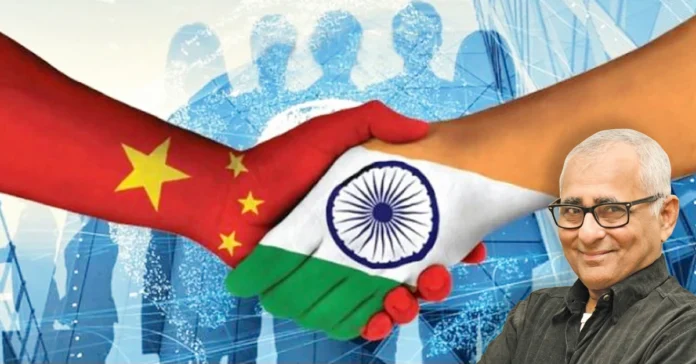By Inderjit Badhwar
In this issue of India Legal, we had a rich harvest of stories vying for our cover. Justice Kamaljit Singh Garewal’s thought-provoking commentary on the death penalty challenges our perspectives on justice and retribution. Columnist Kumkum Chadha’s analysis of the latest Padma Awards dissects the intricate interplay of politics and recognition in India’s highest civilian honours. Our report on Uttarakhand’s implementation of the Uniform Civil Code examines the evolving landscape of personal laws in the country. Yet, amid these compelling narratives, one story stood out as the defining geopolitical moment of our times—the shifting contours of the India-China-America equation, especially in the wake of Donald Trump’s return to the White House.
Why this story? Because in today’s world, geopolitics is no longer an abstract affair confined to government chambers and diplomatic cables. It affects trade, technology, security, and even our daily lives. The India-China relationship, in particular, has been an enduring paradox—marked by economic interdependence and military tensions, diplomatic handshakes and border skirmishes. And now, with Washington entering the equation under a new-old leader, the stakes have never been higher.
India’s Strategic Tightrope
History has shown us that India’s relationship with China is cyclical—periods of diplomatic détente inevitably followed by provocations and disputes. From the 1954 Panchsheel Agreement to the 1962 war, from the Doklam standoff in 2017 to the deadly Galwan Valley clash in 2020, Beijing’s pattern of engagement with India has oscillated between cooperation and confrontation. The recent establishment of two new counties in Aksai Chin—territory that India considers part of Ladakh—has reignited tensions, reinforcing the well-worn pattern of Chinese territorial assertions disrupting diplomatic progress.
Yet, even as India and China navigate this delicate equation, a new factor has entered the mix: the return of Donald Trump to the US presidency. During his first term, Trump’s foreign policy was defined by an aggressive stance against China, trade wars, and a stronger push for India’s role in countering Beijing’s dominance. Now, as he begins his second term, Washington’s China policy remains a “work in progress.” Will Trump seek reconciliation with Beijing, or will his administration double down on strategic competition? More importantly, where does India fit into this equation?
The Quad And The Global Chessboard
One of the key strategic platforms that brings India and the US closer is the Quadrilateral Security Dialogue (Quad), which also includes Japan and Australia. Under Trump’s first term, the Quad gained prominence as a counterbalance to China’s assertiveness in the Indo-Pacific. Now, as Washington recalibrates its China policy, India’s role within the Quad remains crucial.
Secretary of State Marco Rubio’s decision to prioritize a Quad foreign ministers’ meeting within days of assuming office signals Washington’s renewed focus on Indo-Pacific security. But the question remains—will India continue deepening its engagement with the US, or will it seek a more neutral stance to avoid alienating China?
Beijing is watching closely. China has long been wary of India’s participation in the Quad, viewing it as a containment strategy. As External Affairs Minister S. Jaishankar’s recent visit to Washington demonstrated, India has no intention of curtailing its diplomatic engagement with the US, even as it stabilizes relations with China. This balancing act is what makes India’s foreign policy so complex—and so fascinating.
Economic Stakes And Strategic Calculations
Beyond military and strategic considerations, the India-China-US equation also plays out in the economic sphere. China remains one of India’s largest trading partners, despite border tensions and calls for reducing dependence on Chinese imports. Meanwhile, Trump’s “America First” policy and his push for reshoring US manufacturing could create new opportunities for India.
A key concern among Chinese analysts is whether India will position itself as an alternative to China in global supply chains, particularly as Trump reimposes high tariffs on Chinese goods. If India plays its cards right, it could attract significant investment from American companies looking for a new manufacturing base. But Beijing is unlikely to take such shifts lightly, and any economic realignment will have diplomatic consequences.
A Defining Moment In Global Power Play
As we stand at this critical juncture, the India-China-America triangle is more than just a regional affair—it is a defining element of global geopolitics. The interplay of these three powers will shape the future of international trade, military alliances, and technological advancements.
For India, the challenge is to navigate this evolving landscape without becoming a pawn in a larger power struggle. New Delhi must ensure that its growing ties with Washington do not come at the cost of its delicate diplomacy with Beijing. At the same time, it must remain vigilant against China’s historical pattern of territorial aggression and strategic deception.
This is why we chose this story for our cover this week. It is a story of power, strategy, and the fine art of diplomatic balancing—a story that is not just about governments and policies, but about the future of India’s place in the world.
We hope you find our analysis insightful and thought-provoking. As always, we welcome your thoughts and perspectives. The world is changing, and understanding these shifts is more important than ever.


